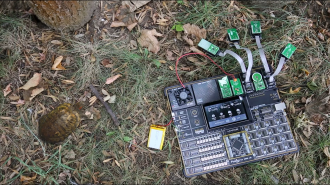
We strongly encourage users to use Package manager for sharing their code on Libstock website, because it boosts your efficiency and leaves the end user with no room for error. [more info]

Rating:
Author: MIKROE
Last Updated: 2020-10-15
Package Version: 1.0.0.0
mikroSDK Library: 1.0.0.0
Category: Other Codes
Downloaded: 109 times
Not followed.
License: MIT license
Turtle Terrarium is the ideal housing for aquatic turtles and other marine reptiles, amphibians, and invertebrates.
This application is using several sensors which show their values on TFT Capacitive Board,
refreshed every few seconds.
Do you want to subscribe in order to receive notifications regarding "Perfect Envirenment - Demo project" changes.
Do you want to unsubscribe in order to stop receiving notifications regarding "Perfect Envirenment - Demo project" changes.
Do you want to report abuse regarding "Perfect Envirenment - Demo project".
| DOWNLOAD LINK | RELATED COMPILER | CONTAINS |
|---|---|---|
| 1599034392_perfect_envirenm_mikroc_arm.zip [4.33MB] | mikroC PRO for ARM |
|

Project description:
- Turtle Terrarium is the ideal housing for aquatic turtles and other marine reptiles, amphibians, and invertebrates.
- This application is using several sensors which show their values on TFT Capacitive Board,
refreshed every few seconds.
- When Water Detect click sense the change, on display will appear picture with two or three blue waves,
depending on the amount of fluid.
- By touching the fan thumbnail, the fan starts working and the current status on the screen changes from OFF to ON.
Hardware requirements:
- Fusion for ARM v8 development board
- MCU CARD for STM32 STM32F407ZG
- TFT Board 4 Capacitive
- Air Quality 4 Click
- Fan 4 Click
- Water Detect Click
- Temp&Hum 6 Click
- UV Click
- Ambient 5 Click
- Pressure 6 Click
- 4 x mikroBUS Shuttle
- 2 x Shuttle Click
- Fan ( DC 5V )
Hardware settings:
- Attach two wires of the fan to Fan 4 Click
- Fusion for ARM v8 Board
- 1st slot: place Air Quality 4 Click
- 2nd slot: place Fan 4 Click
- 3rd slot: place Water Detect Click and Temp&Hum 6 Click
using Shuttle Click and two mikroBUS Shuttle add-ons
- 4th slot: place UV Click
- 5th slot: place Ambient 5 Click and Pressure 6 Click
using Shuttle Click and two mikroBUS Shuttle add-ons
- Place TFT Board 4 Capacitive on Fusion for ARM v8 development Board
Software requirements:
- Mikro C PRO for ARM and CodeGrip Suite
Software settings:
- Open MikroC PRO for ARM program, and first, it is necessary to install packages for
Air Quality 4 Click, Fan 4 Click, Water Detect Click, Temp&Hum 6 Click, UV Click, Ambient 5 Click and Pressure 6 Click from Libstock ( using Libstock manager ). When searching the path for those packages are included, build, and program the code.
- Instead of that, you can just write down the hex file using CodeGrip Suite.
- Enjoy the application :)